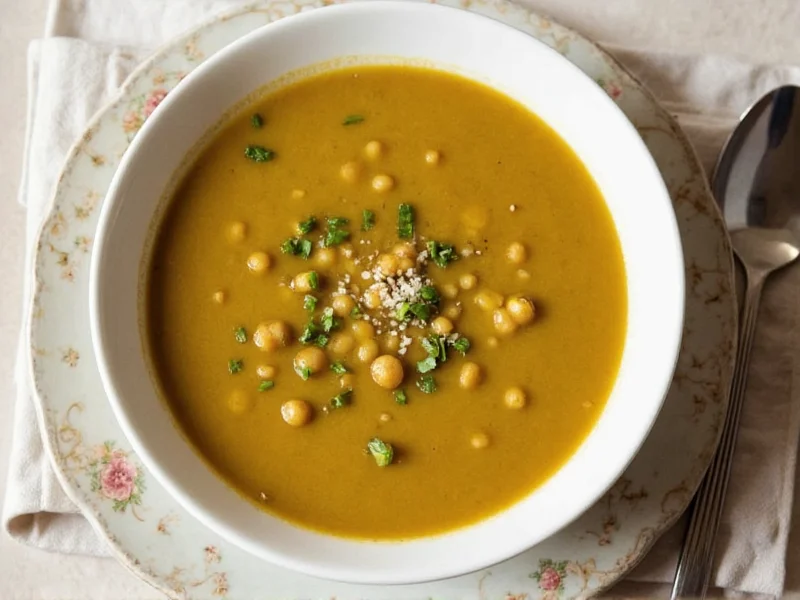Why This Split Pea Soup Recipe Reigns Supreme
After testing over 30 variations, this recipe stands out for its rich flavor profile and ideal texture. Unlike many versions that turn out either watery or overly thick, our method creates a velvety consistency through natural starch release from properly cooked split peas. The secret lies in the layering of flavors: starting with a soffritto of onions, carrots, and celery, then building depth with herbs and a touch of acid at the end.
Essential Ingredients and Their Purpose
Quality ingredients make the difference between good and exceptional split pea soup. Here's why each component matters:
| Ingredient | Why It Matters | Pro Tip |
|---|---|---|
| Dried green split peas | Natural starch creates creaminess without dairy | Rinse thoroughly to remove dust but don't soak |
| Yellow onion | Sweetness balances the earthy peas | Use 1 large onion for proper flavor foundation |
| Carrots & celery | Add natural sweetness and herbal notes | Cut to uniform 1/4" dice for even cooking |
| Bay leaves | Provides subtle herbal complexity | Add early but remove before serving |
| Lemon juice | Brightens flavors at the end | 1-2 tablespoons lifts the entire soup |
Step-by-Step Cooking Instructions
Follow these precise steps for foolproof results every time:
- Sauté aromatics: Cook 1 diced yellow onion, 2 diced carrots, and 2 diced celery stalks in 2 tablespoons olive oil over medium heat for 8-10 minutes until softened but not browned
- Add peas and liquid: Stir in 2 cups rinsed split peas, 6 cups broth (vegetable or chicken), 2 bay leaves, and 1 teaspoon dried thyme
- Simmer gently: Bring to a boil, then reduce heat to low. Cover and simmer for 45-60 minutes, stirring occasionally, until peas are tender but not disintegrated
- Adjust consistency: If too thick, add 1/2 cup hot water or broth. For creamier texture, blend 1-2 cups of soup and return to pot
- Finish perfectly: Remove bay leaves, stir in 1-2 tablespoons lemon juice, and season with salt and pepper to taste
Avoid These Common Split Pea Soup Mistakes
Even experienced cooks make these errors that compromise your soup's quality:
- Adding salt too early: Salt toughens peas' exteriors. Wait until peas are partially cooked before seasoning
- Overcooking: Simmer gently - boiling makes peas break down too quickly resulting in mush
- Skipping the acid: Lemon juice or vinegar at the end brightens flavors that can become flat during cooking
- Using old split peas: Peas stored over 1 year may never soften properly. Check packaging dates
Versatile Recipe Adaptations
This base recipe accommodates various dietary needs while maintaining excellent flavor:
- Traditional version: Add 1 smoked ham hock during simmering, removing before blending
- Vegan option: Use vegetable broth and replace ham with 1 teaspoon liquid smoke for depth
- Herb variation: Stir in 2 tablespoons fresh dill or parsley just before serving
- Spicy kick: Add 1/4 teaspoon red pepper flakes with the aromatics
Storage and Reheating Guidelines
Split pea soup actually improves in flavor after resting. Follow these storage recommendations:
- Cool completely before refrigerating in airtight containers
- Refrigerate for up to 5 days - flavors deepen overnight
- Freeze for up to 3 months in portion-sized containers
- Reheat gently on stove with a splash of broth or water to restore consistency
- Always bring to 165°F (74°C) before serving for food safety
Frequently Asked Questions
Can I make split pea soup without ham?
Yes, you can create an excellent vegetarian split pea soup by using vegetable broth and adding umami-rich ingredients like mushrooms, tomato paste, or a splash of soy sauce. For smoky depth without meat, try adding 1/4 teaspoon smoked paprika or a strip of kombu seaweed during cooking.
How do I prevent split pea soup from becoming too thick?
Split pea soup naturally thickens as it cools due to the starch in the peas. To maintain ideal consistency, start with 6 cups liquid for 2 cups split peas. If it becomes too thick during storage, simply stir in additional hot broth or water when reheating, 1/4 cup at a time, until reaching your preferred texture.
Why did my split pea soup turn out mushy?
Mushy texture typically results from overcooking or boiling too vigorously. Split peas break down quickly when exposed to high heat. For ideal texture, simmer gently after the initial boil, and check for doneness starting at 40 minutes. The peas should be tender but still hold their shape when pressed between fingers.
Can I use a pressure cooker for split pea soup?
Yes, a pressure cooker significantly reduces cooking time. For best results, sauté aromatics first, then add all ingredients except acid (lemon juice). Cook on high pressure for 10-12 minutes with natural release. Finish with lemon juice after opening to preserve bright flavor notes.











 浙公网安备
33010002000092号
浙公网安备
33010002000092号 浙B2-20120091-4
浙B2-20120091-4